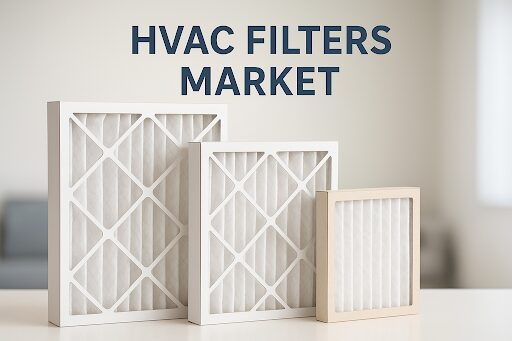Heating, Ventilation, and Air Conditioning (HVAC) systems are central to modern living and working environments. They regulate indoor temperatures, ensure air quality, and provide comfort across residential, commercial, and industrial spaces. At the heart of these systems lie HVAC filters, which are essential in maintaining not only efficiency but also public health by trapping dust, allergens, pollutants, and microorganisms from circulating indoors. Over the last decade, growing urbanization, heightened awareness of indoor air quality, and stricter environmental regulations have propelled the HVAC filters market into the spotlight.
Indoor air quality has become a critical concern in both developed and developing economies. Increasing cases of respiratory illnesses, allergies, and pollution-related health problems have drawn attention to the role of clean air indoors. HVAC filters provide a first line of defense by filtering particulate matter, volatile organic compounds, and microbes, ensuring safer and healthier air circulation. With the rise of commercial complexes, hospitals, data centers, and educational institutions, demand for high-efficiency HVAC filters continues to climb steadily.
Market Growth and Projections
The HVAC filters market size was valued at USD 4.13 billion in 2024 and is expected to reach USD 6.59 billion by 2032 and grow at a CAGR of 6.00% over the forecast period of 2025-2032.
This strong growth projection highlights the expanding use of HVAC systems across various sectors. Factors such as rapid industrialization, the increasing demand for energy-efficient systems, and government initiatives supporting environmental safety further accelerate adoption. Moreover, climate change and rising global temperatures are leading to higher demand for cooling systems, indirectly boosting the market for HVAC filters.
Key Market Drivers
- Rising Urbanization and Infrastructure Development
The global shift toward urban living has created unprecedented demand for commercial buildings, residential complexes, and industrial plants. These developments rely heavily on HVAC systems, which in turn fuels the demand for filters.
- Health and Safety Awareness
Public awareness of indoor air pollutants and their link to respiratory diseases has surged. Organizations and households are now prioritizing high-efficiency HVAC filters to ensure healthier living and working conditions.
- Industrial and Commercial Applications
Manufacturing facilities, cleanrooms, pharmaceutical labs, and healthcare institutions require stringent air filtration to comply with safety standards. This specialized demand adds significant growth momentum to the HVAC filters market.
- Climate Conditions and Energy Demand
Global warming is driving higher use of air conditioning, especially in regions experiencing extreme heatwaves. Consequently, HVAC systems are being deployed on a larger scale, further expanding filter demand.
- Regulations and Standards
Governments and regulatory bodies are introducing strict standards for air quality and energy consumption. This regulatory pressure encourages industries and households to adopt better-performing HVAC filters.
Challenges Hindering Market Expansion
Despite promising growth, the HVAC filters market faces some challenges. The relatively high costs of advanced filters, frequent replacement requirements, and limited awareness in certain developing regions act as barriers. Additionally, industries must balance the need for energy efficiency with the increased resistance that high-efficiency filters place on HVAC systems. Achieving this balance remains a technical and financial challenge.
Emerging Trends in HVAC Filters Market
The industry is undergoing transformations shaped by technological advancements and customer needs:
- Focus on Energy Efficiency: The growing emphasis on sustainable practices is driving demand for filters that reduce energy consumption while maintaining high air quality.
- Customization for Industries: Different sectors require different levels of filtration. Tailored HVAC filters for medical, industrial, and residential applications are gaining traction.
- Rising Demand in APAC: Developing economies in Asia-Pacific are witnessing rapid industrialization and urban expansion, making the region a significant growth hub for HVAC filters.
Regional Overview
- North America continues to lead due to strong industrial and healthcare infrastructure, as well as high consumer awareness of air quality.
- Europe places emphasis on regulatory standards and energy efficiency, pushing for advanced HVAC filter adoption.
- Asia-Pacific shows the fastest growth rate, driven by rapid urbanization, population growth, and rising disposable incomes.
- Middle East and Africa are steadily adopting HVAC systems due to extreme weather conditions and infrastructure projects.
Together, these regions shape a diverse and competitive global landscape for HVAC filters.
Frequently Asked Questions: HVAC Filters Market
Q1. What is the current market size of the HVAC Filters Market?
The HVAC Filters Market size was valued at USD 4.13 billion in 2024 and is projected to reach USD 6.59 billion by 2032, growing at a CAGR of 6.00% between 2025 and 2032.
Q2. What is driving the growth of the HVAC filters market?
Growth is fueled by urbanization, rising awareness of indoor air quality, strict regulatory standards, and expanding use of HVAC systems in residential, commercial, and industrial spaces.
Q3. Which regions hold the largest share in the HVAC filters market?
North America dominates due to advanced infrastructure and high air quality standards, while Asia-Pacific is the fastest-growing region owing to rapid urbanization and industrialization.
Q4. What are the key challenges faced by the HVAC filters market?
Challenges include high costs of advanced filters, frequent replacement requirements, and the technical balance between energy efficiency and high filtration capacity.
Q5. What is the outlook for the HVAC filters market?
The outlook is positive, with consistent growth expected across sectors. Increasing adoption of energy-efficient systems, expanding infrastructure, and rising health awareness will sustain demand through 2032.




